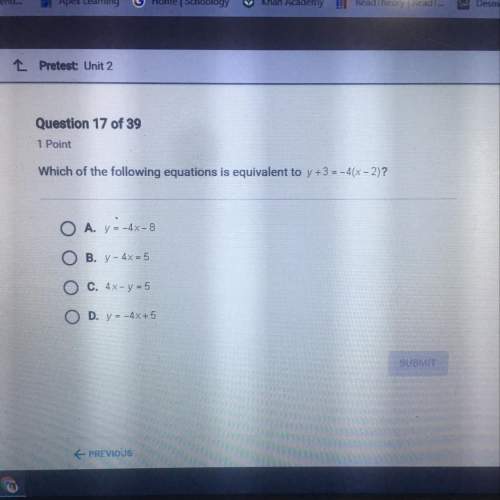
Mathematics, 08.12.2021 17:20 salvadorperez26
Help please, trying to raise my grade
The amount of carbon-14 remaining in an organism, A, is equal to the product of the initial amount of carbon-14 in the organism, A0, and one-half to the power of n, where n is the number of half-lives the organism has experienced.
If a frog initially contained 10 grams of carbon-14 and the half-life of carbon-14 is 5,730 years, how much carbon-14 remains in the frog after 5,730 years?

Answers: 3


Another question on Mathematics

Mathematics, 21.06.2019 16:00
What is the solution to the inequality? 6x−5> −29, a x> −4 bx> 4 cx< 4 dx< −4
Answers: 2

Mathematics, 21.06.2019 16:00
Find the amount in a continuously compounded account for the given condition. principal: $1000, annual interest rate: 4.8%, time: 2 yr
Answers: 3

Mathematics, 21.06.2019 19:30
The cone in the diagram has the same height and base area as the prism. what is the ratio of the volume of the cone to the volume of the prism? h hl base area-b base area =b volume of cone_1 volume of prism 2 volume of cone 1 volume of prism 3 volume of cone 2 volume of prism 3 oc. od. volume of cone volume of prism e. volume of cone volume of prism 3 2
Answers: 3

Mathematics, 21.06.2019 21:30
Are the corresponding angles congruent? explain why or why not.
Answers: 2
You know the right answer?
Help please, trying to raise my grade
The amount of carbon-14 remaining in an organism, A, is equa...
Questions

English, 22.10.2021 23:50

Mathematics, 22.10.2021 23:50

Computers and Technology, 22.10.2021 23:50

Biology, 22.10.2021 23:50


Mathematics, 22.10.2021 23:50



Social Studies, 22.10.2021 23:50

English, 22.10.2021 23:50

Mathematics, 22.10.2021 23:50


Mathematics, 22.10.2021 23:50


English, 22.10.2021 23:50





History, 22.10.2021 23:50




